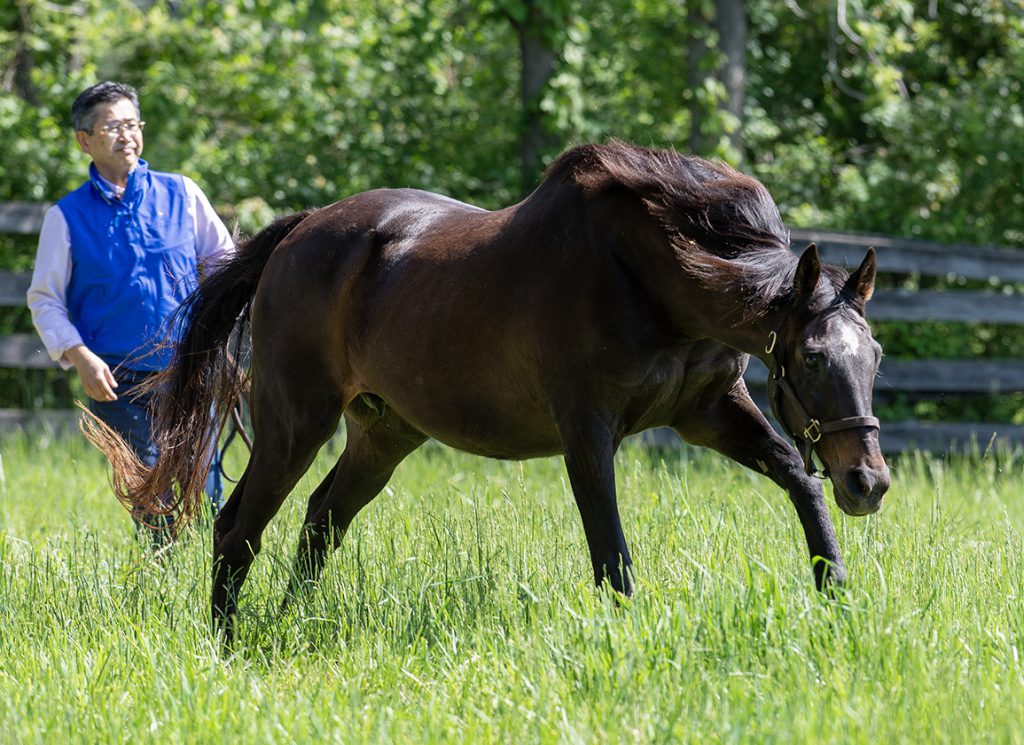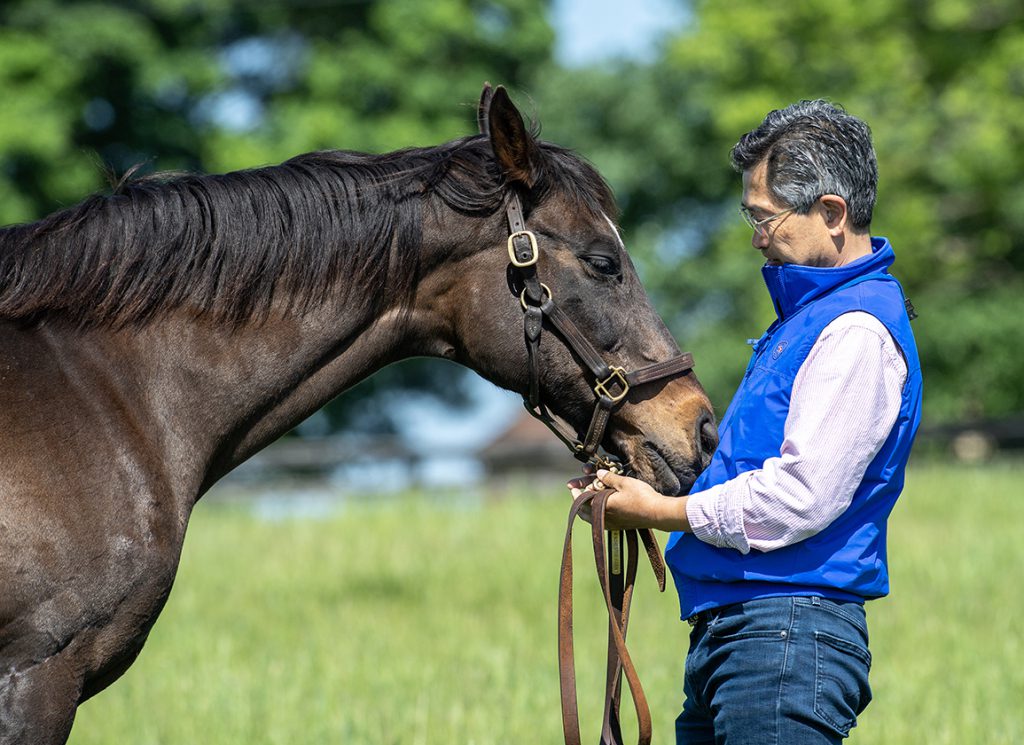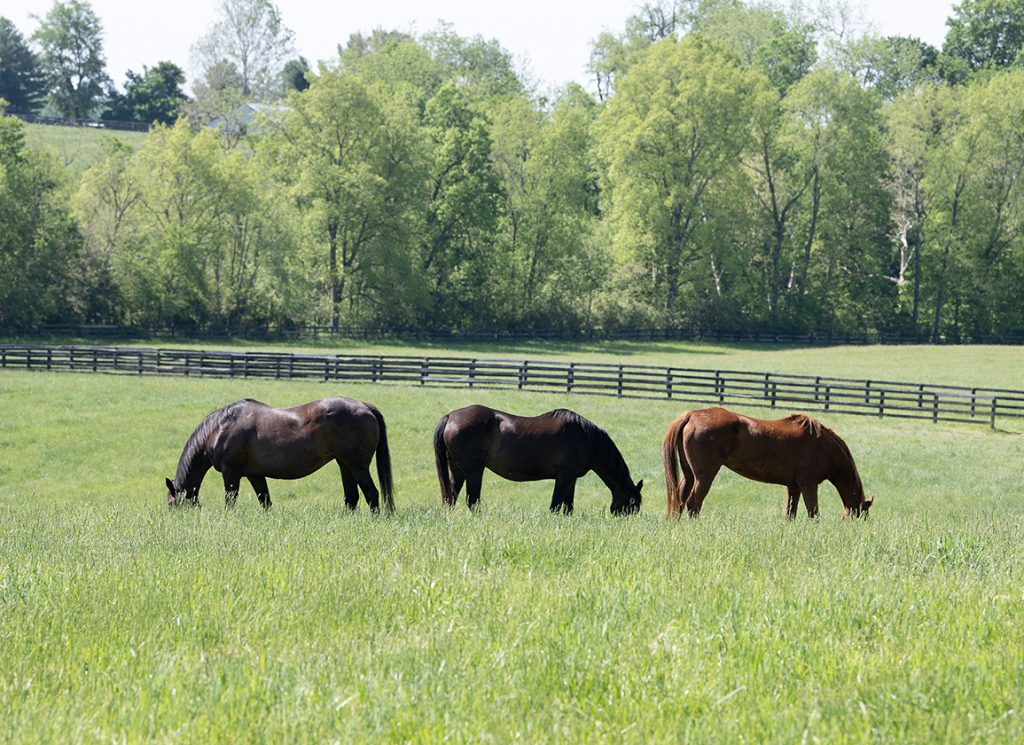Celebrating 40 Years of the Breeders' Cup with Living Legends
Some moments last a lifetime. Breeders' Cup wins are like that. They affect everyone associated with the horse, from owners whose silks the horse sports in the race to breeders to consignors to grooms to farriers and so many others. They even touch those many years down the road, such as those who care for the winner more than a quarter century removed from that magical winner's circle and those signature purple and gold flowers. It is, without a doubt, a privilege to have any association at all with a Breeders' Cup winner.
Dr. Naoya Yoshida of Winchester Farm embraces that honor. He has charge of 1996 GI Breeders' Cup Juvenile Fillies winner Storm Song, believed to be the Breeders' Cup's oldest living winner. The 29-year-old mare has been at his Winchester Farm near Lexington since Dr. Aaron Sones purchased her in 2009.
“We were quite excited to welcome her to our farm,” said Yoshida.” Of course we feel pretty privileged to have these kind of mares.”
Yoshida is a veterinarian and fourth-generation horseman whose family ties to the Thoroughbred industry date back 125 years to his great-grandfather, who bred horses in the U.S. and Europe.
“It's amazing when we work in the Thoroughbred industry, we have this history. I remembered this mare when she was sold at Keeneland November as broodmare prospect [in 1997]. I was training at Hagyard and saw her and never thought I would take care of her in the future. After that I saw her name with a breeding to Dubai Millennium (GB). I used to work for Sheikh Mohammed and saw him try to buy those mares. And the next time I saw her name, she came here [to Winchester Farm]. I feel like it was destiny.”

Winchester's Dr. Naoya Yoshida with Storm Song | Sarah Andrew
Now pensioned after producing six foals during her tenure at Winchester, Storm Song was campaigned by pioneering racing syndicate Dogwood Stable. Dogwood's Cot Campbell, who was a master at finding horses that might have slipped just a little bit through the cracks, bought Storm Song from Lane's End's Book 1 consignment at Keeneland September for $100,000 in 1995. She turned out to be one of the brightest stars to carry the distinctive Dogwood Stable colors, behind her own sire, Dogwood's GI Preakness S. winner Summer Squall. Dogwood had Storm Song for just over two years, selling her as a broodmare prospect at the 1997 Keeneland November sale for $1.4 million to J. S. Carrion. Sandwiched between those two times the filly went through the ring were umpteen thrills for Dogwood partners.
“It was the greatest thrill you can imagine when she won that race [the Breeders' Cup],” said Anne Campbell, co-owner of Storm Song with her late husband, Dogwood founder Cot. “We were particularly thrilled because she was by our wonderful racehorse, Summer Squall, who of course won the Preakness in 1990, so it was just one of the thrills of our lifetime.
“Ironically, Cot woke up about three in the morning [of the race] with vertigo, just sick as a dog. I don't think he felt very well at all during the day, but he forgot about that [when she won]. I remember thinking the paddock in Toronto at Woodbine was so incredibly lovely and classy. The people, the demeanor, just the atmosphere of the whole place. It was a wonderful experience and we were overjoyed that she was clearly going to win before she got to the finish line.”
The year that Storm Song got her Breeders' Cup title was, perhaps, a simpler time. The Breeders' Cup was in only its 13th year in 1996, was being held at Woodbine–the first and only time it was hosted outside of U.S. borders–and was still in its original seven-race, one-day format. The Juvenile Fillies was the first Breeders' Cup race on the card that October day with the looming presence of Cigar's final career start in the Classic just under four hours away.

Yoshida with Storm Song | Sarah Andrew
The 8-5 Juvenile Fillies favorite off a four-length romp in the GI Frizette S. just 20 days prior, Storm Song waited midpack in the Juvenile Fillies, tipped out on the turn, and mowed down her Nick Zito stablemate Love That Jazz (Dixieland Band) to glide clear by 4 1/2 lengths with her ears pricked. Even the Equibase chart called it a “perfect trip.” Storm Song was a no-brainer to be named that year's Eclipse champion 2-year-old filly off the merits of her two Grade I wins, with an extra score in the GII Adirondack S. for good measure. Despite placings at three in both the GI Kentucky Oaks and GI Ashland S., Storm Song never won again and retired after finishing unplaced in the GI Acorn S. at the end of May in 1997. Less than six months later, she was purchased by Carrion.
“We were practical about selling horses when the time came for us to sell them because we weren't in the breeding business,” said Campbell. “It wasn't our thing. We never looked back, we were always glad and so grateful for those horses for what they did. It's a business, so you can't be too sentimental, but you can still love them.”
Storm Song's first foal, Another Storm (Gone West), fetched $1 million as a Keeneland September yearling and would go on to produce European champion Order of St George (Ire) (Galileo {Ire}), as well as GSWs Angel Terrace (Ghostzapper) and Asperity (War Chant). As one of the mares selected for what would be the single and abbreviated book of the brilliant Dubai Millennium, Storm Song was eventually purchased privately by Darley and traveled a good deal during her broodmare career, making three separate trips to Great Britain and even a sojourn to Japan, where she produced her Dubai Millennium daughter before being sent back to Kentucky with a Sunday Silence filly in utero.
She sold again in 2009 to Sones at Keeneland November for $100,000, which is where Yoshida enters her story. Storm Song produced six foals for Sones, including 2016 GI Wood Memorial S. runner-up Trojan Nation (Street Cry {Ire}). Her last foal is the now-5-year-old My Favorite Uncle (Uncle Mo), whose most recent race was a second-place finish at Belterra Park Sept. 20 for Joshua Galindo and trainer Climaco Galindo-Torres. Yoshida raised each of those six.
“She produced good-looking foals,” said Yoshida. “She was a good teacher to me and the farm crew, to see what a good-quality horse is. She's also proven as a broodmare herself.
“She is easy to handle, however, she has kind of a strong personality. She has the dignity of a Grade I-level mare. She's not difficult, but uses her strong personality to show us what she wants to do.”

Storm Song flanked by My Trusty Cat to her left and Plaisir des Yeux to her right | Sarah Andrew
Yoshida keeps Storm Song turned out with 2005 GI Humana Distaff H. winner My Trusty Cat (Tale of the Cat) and 1997 G1 Prix Marcel Boussac-placed Plaisir des Yeux (Fr) (Funambule). The trio are enjoying pensioned life together.
“We keep them in a big field by a creek and forest to keep them calmed down. They gallop so hard, considering their age. We pay very good attention to their feet and change their feeding program if necessary because of cold or hot weather, but these mares are in very good shape. They really don't need special care.”
Yoshida was asked about the first words that come to his mind when he thinks of his Breeder's Cup-winning charge.
“Sophistication. She has a very beautiful eye and face and good conformation. Balance. Dr. Sones still keeps a few daughters of Storm Song, so the story of Storm Song is still going. Hopefully we can give more exciting news from this family.”

The post Storm Song, the Oldest Living Breeders’ Cup Winner appeared first on TDN | Thoroughbred Daily News | Horse Racing News, Results and Video | Thoroughbred Breeding and Auctions.
Source of original post



